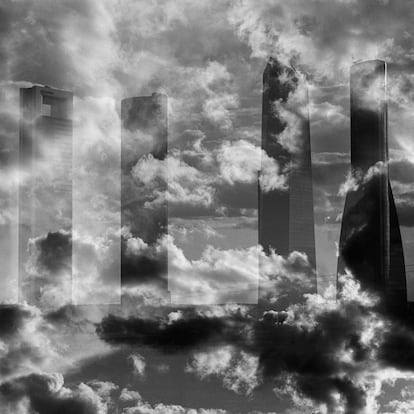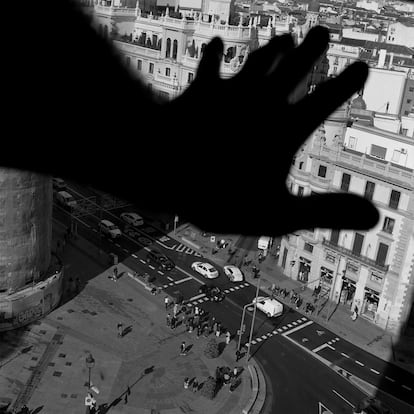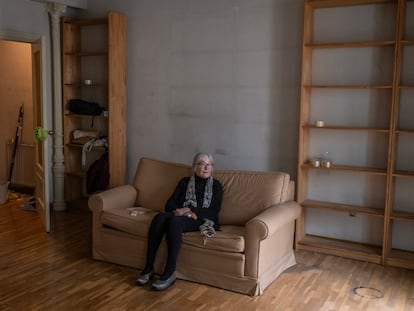
Where are you headed, Madrid?
The Spanish capital is experiencing a period of success and expansion. After years of trying to carve out a niche in the global city scene, it finally seems to have found a model and a brand to go with it. Is it all real or just a facade? And does it lead to an inclusive place to live or is it just for a select few?
In 1892, coinciding with the 400th anniversary of Columbus’s arrival in the Americas, Madrid decided it wanted to be Paris. To this end, it planned the construction of a huge commemorative tower in the heart of Retiro Park. Designed by the architect and engineer Alberto de Palacio, the monument was conceived as an enormous globe, 200m (656ft) in diameter and 300m (984ft) tall, that promised to rival the Eiffel Tower, inaugurated just three years earlier, in terms of its visual majesty and iconic value. But the project was abandoned due to its high cost — around 31 million pesetas at the time, or €186,310 ($211,472).
At the beginning of 2020, Madrid decided it wanted to be London. Begoña Villacís, then the deputy mayor, announced a project to build a Ferris wheel in Tierno Galván Park. At 140m (459ft), it promised to displace the London Eye in the British capital as the tallest structure of its kind in Europe. But a few weeks later the Covid pandemic broke out and the project was dropped, never to be heard of again. Between those two moments, Madrid also attempted to become Las Vegas or Macau, with the failed Eurovegas project in Alcorcón, which included a huge M-shaped building. It even aspired to become the Dominican Republic with the construction of Europe’s largest artificial beach, a mad project that changed plans and locations until its construction in the neighboring province of Guadalajara was considered, albeit without removing the name of Madrid from its nomenclature, as the landlocked capital was not willing to give up such an opportunity to have its own stretch of sand.
There were also four attempts to host the Olympic Games in a not-so-well-disguised desire to be like Barcelona. The first one was in 1972, during the Franco dictatorship; the last one was in 2020, and made additional headlines due to the famous “relaxing cup of café con leche” offered by then-mayor Ana Botella in a promotional video for the bid. Madrid ultimately lost out to Tokyo in what at first seemed like an embarrassment, but in the end, with the pandemic, almost ended up being a blessing.
Madrid was, therefore, the city that unsuccessfully tried to attract attention within the global metropolis framework by following the unwritten rule that said it had to host a major event and/or erect impressive constructions. Then, one night in late March 2021, the photographer Olmo Calvo, on assignment for EL PAÍS, visited the Barrio de las Letras neighborhood in central Madrid — a historic quarter once home to many leading figures of Spain’s Golden Age of literature — to document the revelry taking place there in violation of all the pandemic restrictions. Of all the images he took of that cathartic evening, one stood out in which a girl soared above the hubbub of euphoric young people. The image was reminiscent of Eugène Delacroix’s painting Liberty Leading the People, but instead of the subject holding a French flag, she was carrying a bag from the department store El Corte Inglés. The photograph went around the world, a world languishing within four walls while in Madrid, Liberty was leading its neighbors to the nearest bar.
Four years later, the Spanish capital has just broken its own tourist record (11.1 million visitors in 2024). The nominal GDP — the value of its goods and services — of the wider Madrid region reached €283 billion ($321 billion), ahead of Berlin, Rome, Lyon, or Dublin. According to Eurostat, the Comunidad de Madrid region, which stretches over 8,000 km2 (3,100 square miles), is the fourth-fastest-growing region in the EU in economic terms, and its metropolitan area is experiencing the second-fastest expansion behind Paris, reaching 3,422,416 inhabitants, 23.5% of whom are foreigners. The region of Madrid is expected to reach eight million inhabitants by 2039. At the same time, according to the Madrid chapter of the national trade union UGT, more than 1.3 million Madrid residents are at risk of poverty. One in five earns no more than €500 ($567) a month, and the Gini index, which measures inequality, stands at 35%, below only the exclave Spanish cities of Ceuta and Melilla on the northern coast of Africa.

“After the pandemic, the beer strategy has become oversimplified. There’s much more to it than that, and the Madrid boom comes from much further back,” notes Jorge Dioni, author of books such as La España de las piscinas (The Spain of swimming pools) and Pornocracy. “On the world map, the European Union is small and strange. It has stable governments, a stable currency, citizen security… It’s an extraordinary place. And within Europe, the south also has the climate and the food. People here are nice, and they are open to sex. Madrid is a city of services, and either you keep things open or it collapses. There was no bourgeoisie here, no industry; it’s the only capital in Europe without a port area; even Vienna or Budapest have them or have had them in the past. Madrid is a bit like: ‘Tell me what you’ve got and I’ll manage it for you.’ Keeping everything open during the pandemic had to do with that, and with putting itself on the map. For example, the Teatro Real [opera house] was the first one to open in Europe. People came here to party; we were the Decameron. How could they not come?”
That’s exactly what Financial Times journalist Simon Kuper thought too, and once it became possible, he moved with his family to the Spanish capital for a year. Kuper was already familiar with Barcelona, having worked there, especially writing about FC Barcelona, but he knew next to nothing about Madrid. “I spoke to my friends, and they didn’t know much about this city either. On the international scene, it had grown up in the shadow of Barcelona. We found it a modern, wonderful city, partly because it was wild and unknown. In the minds of northern Europeans, it was a distant city. But that has changed. Madrid is the London of Spain, and it’s beating Barcelona,” the journalist asserts. Barcelona today is that guy who’s nursing his hangover after spending a week in Ibiza and vowing never to go out again. Madrid, on the other hand, is in line to board a flight to the island and spend the weekend of its life after taking out a quick loan.
At the end of his stay in the capital, Kuper wrote a piece in the FT praising Madrid’s virtues. The article went viral and was also mentioned by major Spanish newspapers. “I was surprised by the impact of that story and also of the hundred or so words I wrote about Plaza de Olavide. I think there’s a huge inferiority complex with regard to the Anglo world, a need for validation that seems exaggerated to me.”
A city’s self-esteem comes from outside approval, and much of Madrid’s budget goes towards thatJorge Dioni
Besides what Kuper mentions, what the impact of his article demonstrated is that Madrid may not have yet fully defined its model, but it was undoubtedly already fine-tuning its brand at an enormous speed. “A city’s self-esteem comes from outside approval, and much of Madrid’s budget goes towards that. For example, 20% of the sports budget is allocated to grassroots sports, the rest goes to events,” Dioni points out. For José Manuel Paredes, a marketing and crisis management expert who has worked for consulting firms such as Price Waterhouse, the brand being built in Madrid has nuances that make it special, partly thanks to having arrived late to this sort of global Mortal Kombat that the world’s major cities have become enmeshed in, which has allowed it to participate in the game while maintaining a certain authenticity and mystery. “Politicians have always been accused of having no idea about Madrid, but now they do have a clear idea. They’re looking for a city that’s attractive for investment and attracts talent. Also a dynamic city open to leisure activities. All of this began taking shape at the end of the pandemic. Before that, the paradigm for city branding was the Olympic Games, which were Madrid’s obsession until recently. That attracts politicians; it’s quick and, if well-managed, it’s electorally profitable. Now comes Formula 1, which makes sense from the city government’s perspective. It attracts major events that build a brand and are consistent with the image they want to convey. From that perspective, officials are doing a good job, because they’re not just looking for visitors and tourists, they also want people with money to come and live here, something that’s been worked on a lot in terms of taxation. The problem is when all this clashes with the interests of residents: when so many big events make your life miserable, or when you can’t afford the rent anymore. The brand must respect the public and be consistent with it." Paredes is also a spokesperson for the Neighborhood Association of People Affected by the Bernabéu [soccer stadium].
“Fill yourself with energy.” Each city needs its own brand and each brand needs its own campaign. For Marisol Ruiz and Patxi Fernández of Move Branding, a brand-building agency that has worked for Inditex, the parent company of Zara, this would be a good slogan for Madrid. “We hear a lot of ‘fill yourself with nature’ to sell a place that lets you disconnect. Madrid is the opposite: a place where you can connect, where things happen all the time. We see it as a place with energy.” According to them, the key to making this type of campaign work is not only to seduce the outsider, but also to reinforce in residents a pride of belonging. “The balance between what we want to project and who we really are is vital. If that balance is broken, the brand is weakened,” they conclude.
This capital is searching for its identity and has found it in successVicent Molins
So Madrid is a party, with GDP growth 0.2% above the national average in 2024. It has been the region that receives the most foreign investment in Spain for 13 years now (more than 67% in the last fiscal year). It’s also the European capital with the third-most hours of sunshine (almost 3,000 a year, behind Athens and Rome) and the one with the second-highest average temperature (18ºC or 64ºF), surpassed only by the Italian capital. But is everyone invited to this party? Obviously not. This is a 21st-century European city, not Narnia. Yet the truth is that it has succeeded in filling with pride and satisfaction many of those not officially invited. “You think that one day they’ll let you in, but no, they’ll never let you in,” Dioni points out. For Vicent Molins, author of the book Clickbait City, the Spanish capital must decide whether it wants to be a brand or a city for its citizens. “I think it’s clear. As a brand, I predict a great future. As a city, I’m not so sure. So much marketing requires citizens to step back a bit for it to succeed. This capital is searching for its identity and has found it in success.”
Yet Luis Arroyo, a political communications expert and current director of the Ateneo cultural center, points out that Madrid is “a city that doesn’t think much.” He clarifies: “There’s very little room for debate and analysis. Perhaps it’s been endemic because many people have always felt they were just passing through, but the truth is that it’s difficult to create a city model without thinking, and thinking remains a pending issue in this city. What do we want to be now? Miami?” A little, yes. The idea that Madrid is the Miami of Europe hovers over the streets of the posh Salamanca neighborhood, supporting in a more or less veiled way the idea of a second Latin American capital outside the geographical confines of Latin America.
This year, the Latino population living in the Madrid region reached one million people, a result of the wave of migration that began more than a quarter of a century ago and which, not without its problems, has been an example of successful integration. It also marked the arrival of a considerable contingent of millionaires from overseas. “I don’t think this will end up being Miami, and I don’t think the influence of these people on the city’s political life will be comparable to what the Russian oligarchs have had and continue to have in London,” Kuper points out. Dioni disagrees. “They look for a foothold in Europe in case things get ugly in their country, and from that foothold they influence their territory. And in this one, well, maybe too. Remember the demonstrations on Ferraz Street [home to the headquarters of the governing Spanish Socialist Workers’ Party]? Well, that form of pressure isn’t coming from here, it’s not European,” says Dioni.
In Madrid, there’s very little room for debate and analysis. Perhaps it’s been endemic because many people have always felt like they were just passing throughLuis Arroyo
Manuel Melis was a civil engineer. In 2003 he oversaw the remodeling of the M-30 ring road, parts of which were brought underground. This project, with 66 km (41 miles) of tunnels and a network of secondary roads around the Manzanares River, was completed four years later. He also oversaw the expansion of the capital’s subway system. “He was the true architect of what has been the greatest urban transformation in the city of Madrid,” acknowledged former mayor Alberto Ruiz-Gallardón on January 20 at a tribute to the engineer a few months after his death. “We promised 50 new kilometers of metro in eight years, and in the end we achieved 80. Melis was key with his innovative way of building tunnels,” adds Manuel Cobo, who after serving as head of the finance department in the regional government led by Ruiz-Gallardón, went on to become deputy mayor between 2003 and 2011. That administration is remembered for its pharaonic projects, which multiplied the city’s debt sevenfold, and for its Olympic ambitions: Cobo himself was responsible for the candidacies.
The foundations for today’s ambitious and global Madrid, for the city that’s always busy doing things, were laid then, but also, as the politician says, a modern city was built, equipped with infrastructure that sought to improve the lives of Madrid residents, financed by both the local and regional governments, both then in the hands of the conservative People’s Party (PP). The expansion of Barajas Airport — now the second-largest in capacity and fifth in operations in Europe — the municipal emergency social services, the first recycling policies, the resident parking zone, the pedestrianization of central arteries like Arenal and Callao, a tennis stadium (Caja Mágica) with a retractable roof before even Roland Garros or Wimbledon had one… Also built were up to 29 rainwater tanks, underground infrastructure that Cobo now boasts about as key to ensuring the city doesn’t flood during months of heavy rains. “It wasn’t a matter of identity, but rather a desire to get things done.”
The current mayor, José Luis Martínez-Almeida, also of the PP, not only agrees with Cobo but raises the stakes: “We are experiencing the best moment in our history. We have become the second-largest urban tourist destination in the world, and the first in conference tourism. But we are not satisfied with that and want to continue growing as a city, leaving no one behind, maintaining the essence of our neighborhoods while modernizing public spaces. The main challenge facing Madrid and the world’s major capitals is housing. We are committed to providing solutions to this problem.”
Enma López, a Socialist city councilor, disagrees with the mayor’s triumphant vision. “Almeida has been leading this city for six years now. What has he improved? Nothing. The city is becoming more difficult and more expensive by the day. The housing price increase is impossible; you can’t rent a place, you can’t buy a place: you just can’t live in Madrid. There’s still a huge inequality gap. How can it be that life expectancy depends on the postal code you live in?”
We’re experiencing the best moment in our history. We’ve become the world’s second-largest urban tourist destination, and the first in conference tourismJosé Luis Martínez-Almeida
“We made a commitment to creativity and citizen participation in the neighborhoods,” says Manuela Carmena, who served as mayor from 2015 to 2019, a period during which the low-emissions zone Madrid Central was launched and work began on the renovation of Plaza de España. An unprecedented period of détente with Barcelona also began, coinciding with Ada Colau’s term as mayor of the Catalan capital. Without completely breaking with what had been building up, Carmena’s city was also committed to a certain kind of humanism and, above all, it focused on one element: climate change, which even the FT reporter Kuper, in his short time in Madrid, noted was not being addressed seriously. “Now it’s a fabulous place to live, but the summers are already harsh and it’s going to get worse,” notes the journalist about a region that by 2050 is expected to have the same temperature as Marrakech today.
Javier García-Germán and Alejandro Valdivieso are the two architects who lead El futuro Madrid, the magazine published by COAM (Official College of Architects of Madrid), and which has already published several issues dedicated to territory, inclusion, and climate. “Madrid’s challenges are enormous and they have to do with its way of growing and integrating new developments. And a lot of it also has to do with its climate. Constructions from North Africa are already being studied,” note the architects, who are also concerned about the possibility of the city center becoming devoid of residents and turning into a sort of pop-up neighborhood with only leisure options for visitors. “The city center has social and political value; it unites residents; it is the city’s political soul. Emptying it out means emptying the city of emotional content.”
“We have the impression that Madrid is competing with Miami, Buenos Aires, and São Paulo. That we are no longer of interest to it. That for Madrid, Spain is now simply the place to go looking for small and medium-sized businesses for sale to improve its own position, sector by sector, before making the leap across the pond.” This is what the Catalan politician Pasqual Maragall wrote on February 26, 2001, in a column for EL PAÍS entitled Madrid is leaving. Maragall’s analysis was accurate in certain aspects, but erred on a key one: for the rest of Spain, Madrid isn’t leaving, it’s coming. “It’s like a teenager who wants everything and doesn’t say no to anything,” Dioni notes. “Right now, I would recommend that a city like San Sebastián stop wishing for the arrival of the high-speed AVE rail link, because it might make it easier to travel to Madrid to see The Lion King, but the problems of connecting itself to the capital would be much deeper. That’s why Lisbon refuses to approach Madrid, a city which at one point after Brexit even believed it could take the banks away from the City of London. How are you going to take that away from the guys who invented piracy?”
Madrid’s challenges are enormous and have to do with its way of growing and integrating new developmentsJavier García-Germán and Alejandro Valdivieso
Madrid is hungry and omnivorous, even though it still needs to grill its croissants to make them taste like something. It crunches through major sporting events and foreign students (attracting up to 20,000 of the estimated 150,000 studying in Spain). This causes imbalances with the rest of the territory, and traces of Madrid-phobia occasionally surface against the expansionist ambitions of the now city-region. Fernando Caballero, author of the book Madrid DF, believes there’s no point in resisting the capital’s attacks; his is a proposal in tune with a world in which 56% of its inhabitants live in large cities, a figure that is expected to reach 70% by 2050. “What we need to do is create institutions to coordinate this. Consortiums will be needed to manage the city’s expansion.” Caballero advocates for a polycentric city that extends its tentacles beyond the confines of the community. “Turn the rural world into a metropolitan one, weave a mesh in which cities overlap. This is the way to ensure the city doesn’t become decoupled and grows with its back to the territory,” he notes. His proposal is based on embracing an inescapable reality through pragmatism, leaving behind emotional elements. “The city must explain itself. Of course, if we continue to encourage making fun of it and extracting political gain from the confrontation, Madrid may decide to set up its own business.” And then Maragall’s forecast will end up being more prophetic than it may seem today.
Sign up for our weekly newsletter to get more English-language news coverage from EL PAÍS USA Edition
Tu suscripción se está usando en otro dispositivo
¿Quieres añadir otro usuario a tu suscripción?
Si continúas leyendo en este dispositivo, no se podrá leer en el otro.
FlechaTu suscripción se está usando en otro dispositivo y solo puedes acceder a EL PAÍS desde un dispositivo a la vez.
Si quieres compartir tu cuenta, cambia tu suscripción a la modalidad Premium, así podrás añadir otro usuario. Cada uno accederá con su propia cuenta de email, lo que os permitirá personalizar vuestra experiencia en EL PAÍS.
¿Tienes una suscripción de empresa? Accede aquí para contratar más cuentas.
En el caso de no saber quién está usando tu cuenta, te recomendamos cambiar tu contraseña aquí.
Si decides continuar compartiendo tu cuenta, este mensaje se mostrará en tu dispositivo y en el de la otra persona que está usando tu cuenta de forma indefinida, afectando a tu experiencia de lectura. Puedes consultar aquí los términos y condiciones de la suscripción digital.
More information
Archived In
Últimas noticias
Christmas loses its festive spirit: ICE fears cast shadow over religious celebrations
‘Sleepless City’: The light of cinema illuminates Madrid’s Cañada Real shantytown
All the effects of gentrification in one corner of Mexico’s Colonia Roma
Palestinian reporter Youmna El Sayed: ‘My family told me I had to choose between being a journalist or a mother’
Most viewed
- The low-cost creative revolution: How technology is making art accessible to everyone
- Christian Louboutin: ‘Young people don’t want to be like their parents. And if their parents wear sneakers, they’re going to look for something else’
- US sanctions against jailed cartel leader ‘El Marro’ highlight Mexico’s lack of control over its prisons
- Families demand repatriation of bodies of Colombians who died in Ukraine: ‘This war is a slaughterhouse for foreigners’
- Liset Menéndez de la Prida, neuroscientist: ‘It’s not normal to constantly seek pleasure; it’s important to be bored, to be calm’











































